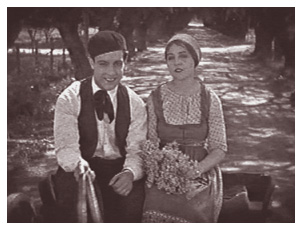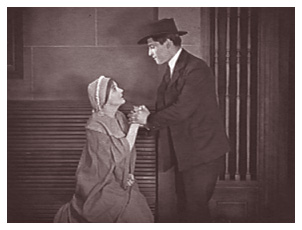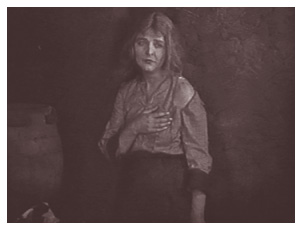

Released September 8, 1924
Metro-Goldwyn Pictures
Written and Directed by Fred Niblo
Cast: Enid Bennett (Marise La Noue), Ramon Novarro (Jean Leonnec), Wallace Beery (Bobo), Frank Currier (Hugo Leonnec), Rosemary Theby (Nana), Mitchell Lewis (D'Agut), Risita Marstini (Madame Charpied), Sydney Franklin (Her Husband), George Nichols (Concierge), Emily Fitzroy (Madame Bouchard), George Periolat (Papa Bouchard), Milla Davenport (Madame Pousot), Gibson Gowland (Le Turc), Dick Sutherland (The Toad)
Jean and Marise are childhood sweethearts in a French village,
he the son of the mayor, she the daughter of a poor cobbler. When
the cobbler dies, she must go to live with relatives who are mean
to her. When she runs back to her empty home to avoid a beating,
Jean finds her. They spend the night together in front of the
fire. Jean's father discovers them and orders Marise to leave
town. Jean goes with her, and they head to Paris to get married.
They are separated at the train station when Jean goes to look
for a priest to marry them, and he is picked up by detectives,
falsely accused of stealing money from his father. He escapes
from the train trip home, and when he returns to the station,
he cannot find Marise. Weeks and months pass, and they cannot
find each other in the big city. Marise tries to work, but she
is either propositioned by her bosses or the factory where she
was working closes. She turns to prostitution. Jean meets up with
a small-time crook named Bobo and becomes a thief. Although the
real thief of his father's money is found, Jean does not know
this and still thinks he must hide from the  police.
While running from the police one evening, he happens upon a woman
in a dark doorway who offers him a hiding place. When he gets
inside, he sees a worn, haggard, unkempt woman in rags - it is
Marise. He realizes what she has been doing for a living, strikes
her and runs from the room. When he is shot by the police, he
returns, and she spends weeks nursing him back to health. He still
wants nothing to do with her. Bobo comes and takes Jean with him
back to the crooks' hideout, a seedy bar. Bobo invites Marise
to come along, and she readily follows. After Jean turns Marise
over to an ugly patron named Toad so that the man may "have
his way with her," he is torn between what he has done and
his love for her. Police raid the place, and Marise helps Jean
escape. He later learns she is in a hospital dying, but, if he
goes to see her, he is sure to be captured by the police.
police.
While running from the police one evening, he happens upon a woman
in a dark doorway who offers him a hiding place. When he gets
inside, he sees a worn, haggard, unkempt woman in rags - it is
Marise. He realizes what she has been doing for a living, strikes
her and runs from the room. When he is shot by the police, he
returns, and she spends weeks nursing him back to health. He still
wants nothing to do with her. Bobo comes and takes Jean with him
back to the crooks' hideout, a seedy bar. Bobo invites Marise
to come along, and she readily follows. After Jean turns Marise
over to an ugly patron named Toad so that the man may "have
his way with her," he is torn between what he has done and
his love for her. Police raid the place, and Marise helps Jean
escape. He later learns she is in a hospital dying, but, if he
goes to see her, he is sure to be captured by the police.
"The Red Lily" is a story you'll either love or hate, as exemplified by the reviews of the time. Harrison's Reports (August 9, 1924) said, "It is difficult to understand how a director of Mr. Niblo's ability could ever imagine that 'The Red Lily,' a story of which he is the author, was a story fit for a motion picture," whereas the New York Times (September 29, 1924) reviewer said, "To us, it is one of the outstanding film efforts of the season. The acting of the players is beyond reproach, and the various situations are worked out with stirring suspense."
"The Red Lily" is melodrama at its height. It is filled with emotion and moves the viewer; however, it is a dark, dreary tale. Fred Niblo was one of the outstanding directors of the silent era ("The Three Musketeers" - 1921, "Blood and Sand" - 1922, "Ben Hur" - 1925, "The Temptress" - 1926, etc.). "The Red Lily" was his attempt at an original story that was obviously influenced by Chaplin's "A Woman of Paris" which was released the previous year. Although a strong story, Niblo, unfortunately, did not succeed as Chaplin did with his French drama.
The Harrison's Reports reviewer goes on to explain the reasons for his disdain with the movie - reasons which are valid. ". . . the two principal characters, whom he meant to pass as hero and heroine, perform acts that are revolting to normal people," he notes. "The hero becomes a crook, and the heroine a prostitute . . . The hero does not become a crook because someone held him under his power; he turns into one simply by his weakness of character. Such a lack of character naturally disqualifies one for he honors of a hero."
As noted, the viewer will either love or hate the story, and the Harrison's Reports reviewer outlines the very reasons some will not like Niblo's tale. However, the New York Times reviewer takes a more pragmatic view, stating, ". . . the troubles that beset Marise la Noue (Enid Bennett) in the French metropolis are just those which might happen to any unsophisticated girl of comely appearance."
As for Novarro's Jean Leonnec, he tells his father at the
beginning of the film he plans to marry Marise when he "comes
of age." Exactly what that age may be, we do not know, but
he is  obviously very young - possibly
not yet 18 years of age. To find himself alone and broke in Paris
- refusing to give up his search for Marise - it is easy to understand
how he could come under the influence of an older, experienced
crook such as Bobo. After all, we never once see a gun - they
appear to be petty thieves, nothing more - crimes that show a
weakness of character, not meanness or disregard for human life.
Niblo deserves credit, too, for creating a situation that would
make it easy for Jean to turn to a life of crime. Remember, he
was falsely accused of stealing money from his father, was arrested
by detectives and escaped. He was labeled a criminal before he
ever thought of being one and still believed himself to be a criminal
on the run.
obviously very young - possibly
not yet 18 years of age. To find himself alone and broke in Paris
- refusing to give up his search for Marise - it is easy to understand
how he could come under the influence of an older, experienced
crook such as Bobo. After all, we never once see a gun - they
appear to be petty thieves, nothing more - crimes that show a
weakness of character, not meanness or disregard for human life.
Niblo deserves credit, too, for creating a situation that would
make it easy for Jean to turn to a life of crime. Remember, he
was falsely accused of stealing money from his father, was arrested
by detectives and escaped. He was labeled a criminal before he
ever thought of being one and still believed himself to be a criminal
on the run.
Although Niblo's story incurs harsh criticism, his direction is given its just credit. There are some outstanding moments in the film that make it memorable.
For example, when Marise goes to live with relatives after her father's death, the man is a mean alcoholic, the wife a shrew, and their four young children are treated harshly by their parents. One stormy night when the father tries to beat the oldest girl, she runs to Marise for protection. Angered, the man comes after Marise with a whip. Marise runs from the home into the blackness of the night, rain pouring down and lightning flashing all about. She dashes into the barn to hide, but the man sees her and follows. Niblo makes the most of this stirring scene as Marise crawls from one stall to the other, in and about around horses trying to elude the madman who is after her. Finally, she runs out of the barn and off into the night. The scene is gut-wrenching with the viewer breathing a sigh of relief when she finds safety by returning to her old, empty home.
Niblo also adroitly teases us with situations when the two lovers are so very close to finding each other but frustratingly barely miss meeting. In one example, Marise has waited at the station for Jean's return until the early morning hours not realizing he was taken away by the detectives. After escaping from the train, Jean found his was back to the train station after many hours of evading anyone in a police uniform. He slinks past a pillar into the station while, at the same moment, Marise emerges from the other side of the pillar to go out into the bustling street. When Jean comes back out, he, unfortunately, goes in the opposite direction to look for her.
Weeks later, Marise goes to a walkway by the Seine River
and sits on a bench. A man is on the bench directly behind her.
It is Bobo, a small-time crook. There is only one other person
in the frame, a man who is standing with his back to us at the
wall looking out at the river. First Bobo surreptitiously takes
the few coins Marise has in her purse and then tries to "get
friendly" with her. She leaves in disgust at his advances.
Bobo goes over and asks the man at the wall for a cigarette. It
is Jean! Once again, the two lovers have come so close to finding
 each other, but, alas . . .
each other, but, alas . . .
Niblo makes it very clear, too, that Marise didn't immediately turn to prostitution as an easy way to earn money. She is first shown scrubbing the stone steps of a public building on her hands and knees. The superintendent tells her this work is too hard for her and invites her into his office. Much to her delight, he promises her an easier job in the cloak room. However, when it is obvious he wants "favors" in return, she backs away and asks if she must endure this again. This makes it clear she has encountered this type of behavior before - and we assume she has lost jobs before for being "uncooperative." As expected, she is fired.
Next we see her and possibly a hundred other women emerging in work clothes from a factory. She is stone-faced, walking as if in a trance. The scene looks as if it were lifted from "Metropolis" which was made a year later. A sign in the background states that the factory is closing.
These scenes provide a prelude to next seeing Marise in gaudy clothes and heavy make-up in a bar with a sailor, smoking, drinking and laughing. No doubt the viewer wants the heroine to be strong and beyond reproach - as the Harrison's Reports reviewer felt was best for Niblo's story. However, Niblo must have determined the course Marise chose was necessary to add more realism and emphasize her destitution. Certainly, the power of his story would have been weakened had the heroine not "fallen."
Actually, the actions of Novarro's character are deserving of criticism. Certainly, as a young boy/man, he is idealistic, and we can understand that in spite of his own shortcomings, he would feel that Marise would remain the pure, innocent girl he knew in the small village. However, when this unknown prostitute invites him into her room to hide from the police one dark night, and he discovers it is Marise, he raises both fists in the air and knocks her to the floor. Niblo's direction in this scene must be singled out as exceptional because it is not only graphic, it is shocking, as well. However, we lose sympathy for Jean at this point for his brutal response - but, is it what one would expect from an idealistic young man? Of course, the pitiable Marise is made all the more pitiable as she crawls across the floor toward him, her cheek oozing blood from the blow, saying, "I waited for you . . . I waited so long, but you didn't come back." He runs from the room in revulsion, and she clings to the table continuing to say, "I waited so long . . ." Niblo is to be praised for not only superb direction, but an exceptionally moving scene.
Regarding the acting, Enid Bennett, who was Niblo's wife, stands out among the players with the most outstanding performance. The New York Times reviewer said, "Miss Bennett gives one of the most remarkable performances ever seen on the screen in this production. Disappointment and despair are written on her wistful face, and she is just as able in her portrayal of the woman who would starve rather than disappoint the man she loved." Essentially, Bennett is called upon to give three performances, all of which deserve praise. As the film opens, she is a lovely young girl, exuding the innocence of a world that consists of her little village and a simple life as the daughter of a humble cobbler. Miss Bennett's beauty is an ethereal one (a word used quite often to describe Lillian Gish), and the New York Times' choice of "wistful" to describe her face is an apt one. However, we see a change later in the film - a flirtatious, overly made up, carefree prostitute plying her trade first with a sailor, then with a most disgusting large man who apparently has had too much to drink and mistreats her. Surprisingly, she gives a very good performance as a fallen woman who is led to a life that would have previously seemed impossible for the innocent country girl.
But where she becomes the extraordinary actress is as the prostitute who has obviously been beaten down by life so that she has lost all self-esteem, in addition to a body that has suffered from the life she leads - a most distressing change in appearance from the rowdy prostitute we saw in the bar. She is dressed in ragged clothing, her face is drawn with dark circles under her eyes, she is slightly bent, and the eyes and mouth convey someone who is beyond feeling and simply existing. We see a slight sense of shame when she realizes it is Jean looking at her in the room's dim light, but, suddenly, it doesn't matter. Her life is what it is, and the fates have dealt their hand. All of this can be read into her face, her eyes, her body. When Jean strikes her down and she drags herself, bleeding, across the rough wooden floor giving the only excuse she has, "I waited for you . . . I waited so long," we are given an emotionally stirring performance that remains in our memory long after the film has finished. Enid Bennett did not make a lot of movies during the silent era, at least not in comparison with most of her contemporaries; however, there are films we can see today in which she is delightful such as Douglas Fairbanks' "Robin Hood" (1922) and Milton Sills' "The Sea Hawk" (1924), both exciting costume epics in which she serves well as a beautiful heroine.
Ramon Novarro was consistently good in his silent movie roles, having served early on under the wing of a top-notch director - Rex Ingram. Ingram believed in the young Mexican actor and, groomed him, and, after standing out in several supporting roles, starred him in such films as "Scaramouche" (1923) and "The Arab" (1924). Novarro's biggest claim to fame was as "Ben Hur" (1925), and he went on to star in several outstanding MGM silents actually becoming their top male star for a period of time.
 His portrayal in "The Red
Lily" is good; however, as noted by the Harrison's Reports
reviewer, it is one that does not generate sympathy. The scene
where Jean strikes Marise has already been outlined, but there
is another scene in the film that disturbs us regarding the character
of Jean. After Marise has spent weeks nursing him back to health
from a gunshot wound, he quickly deserts her when Bobo arrives
at the room. Why Bobo tells Marise to come along, we do not know,
but she does - following behind the two like a puppy. At the seedy
bar, there is a crowd gathered and glad to see Jean return. A
prostitute in the bar whom he had previously avoided is now kissed
passionately by Jean, all for Marise's benefit. A burly, ugly
man (played by Dick Sutherland) aptly named Toad, is essentially
avoided by everyone. He goes into a back room obviously intoxicated.
Jean, either for retaliation at Marise's lifestyle or to assure
the crowd that he is not associated with her, shouts, "I
don't know her . . . Let the Toad have her . . . That's all she's
fit for now." Then he pushes her into the room with Toad
and shuts the door. As the revelry continues, Jean can't take
his eyes off the door. He listens at the door and, at one point,
even raises his hands to beat on the door, but resists. Suddenly,
the door opens. Toad emerges disheveled and with several scratches
on his face. Marise is in the corner of the room, blouse torn,
but obviously unharmed having defended herself successfully. As
noted, Jean's behavior hardly leads one to think well of him no
matter how much he may have "agonized" thinking about
what was going on behind the closed door. Nevertheless, Novarro
was a talented actor who would rise to the occasion no matter
what the role - and he does so in "The Red Lily," although
the writing of the part does warrant improvement.
His portrayal in "The Red
Lily" is good; however, as noted by the Harrison's Reports
reviewer, it is one that does not generate sympathy. The scene
where Jean strikes Marise has already been outlined, but there
is another scene in the film that disturbs us regarding the character
of Jean. After Marise has spent weeks nursing him back to health
from a gunshot wound, he quickly deserts her when Bobo arrives
at the room. Why Bobo tells Marise to come along, we do not know,
but she does - following behind the two like a puppy. At the seedy
bar, there is a crowd gathered and glad to see Jean return. A
prostitute in the bar whom he had previously avoided is now kissed
passionately by Jean, all for Marise's benefit. A burly, ugly
man (played by Dick Sutherland) aptly named Toad, is essentially
avoided by everyone. He goes into a back room obviously intoxicated.
Jean, either for retaliation at Marise's lifestyle or to assure
the crowd that he is not associated with her, shouts, "I
don't know her . . . Let the Toad have her . . . That's all she's
fit for now." Then he pushes her into the room with Toad
and shuts the door. As the revelry continues, Jean can't take
his eyes off the door. He listens at the door and, at one point,
even raises his hands to beat on the door, but resists. Suddenly,
the door opens. Toad emerges disheveled and with several scratches
on his face. Marise is in the corner of the room, blouse torn,
but obviously unharmed having defended herself successfully. As
noted, Jean's behavior hardly leads one to think well of him no
matter how much he may have "agonized" thinking about
what was going on behind the closed door. Nevertheless, Novarro
was a talented actor who would rise to the occasion no matter
what the role - and he does so in "The Red Lily," although
the writing of the part does warrant improvement.
Little can be said of Wallace Beery that isn't said about all of his performances. He's a top-notch actor who never tries to be anything more than himself. His ease of acting gives a naturalness of character no matter what the role. Once again, he is enjoyable as the likeable Bobo in this film.
Great directors will provide us something in each film that goes beyond the story to add to the emotion or simply an ingenious, usually running, "bit" that makes it all the more enjoyable. Niblo has done that with "The Red Lily" by having Jean constantly refer to Marise as having "the face of an angel" - and certainly we agree in the early portions of the film. In the beginning, he tells his father, "She is as pure as an angel." When he meets Bobo for the first time and explains he is looking for his lost love, Bobo replies, "Why worry about one woman? There are plenty more in Paris" - to which, Jean answers, "None like her . . . she has the face of an angel." This reference is made at other times without being repetitious, but it become very significant and poignant on that night when Marise hides Jean in her room, lights the oil lamp, and he sees a very "un-angelic" Marise. When Bobo, Jean and Marise leave her room and go to the seedy bar where all the petty thieves hang out, the crowd welcomes Jean back - then they look in the corner at the pitiful, ragged and disheveled figure and say, "So, this is the angel you've been searching for so long!" Then they all laugh and turn back to the bar for their celebration - a very touching scene that makes us realize the significance of Niblo's recurring "face of an angel" phrase throughout the story.
The direction and acting are exceptional, and the cinematography is top quality. As the New York Times reviewer stated, "There is striking fidelity to the locale about the settings, particularly the exteriors. While watching this picture, one is taken to a French village and to Paris, the action and characterization exuding the atmosphere of France."
Once again, it must be noted that the film is a dark, gritty story that will not be to everyone's taste. What Niblo may lack in story construction, he makes up for in emotion and direction. While it may not measure up to Chaplin's "A Woman of Paris," Niblo's "The Red Lily" cannot be passed up.
The version reviewed is produced by Turner Classic Movies, distributed by Warner Archives, and includes a liltingly appropriate original orchestral score by Scott Salinas.
Copyright 2010 by Tim Lussier. All rights reserved.